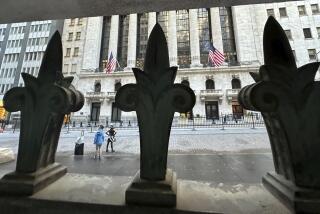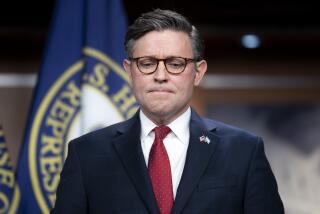Default Threat Looms, but Investors Unruffled
If Washington is indeed headed for its scheduled fiscal train wreck, the crossing gates will begin coming down this week.
The U.S. Treasuryâs quarterly ârefundingâ--an auction of $31.5 billion in three- and 10-year notes--is set for Tuesday and Wednesday. But the sale is likely to be suspended unless Congress raises the federal debt ceiling, now $4.9 trillion.
And the debt ceiling, as even casual observers of politics must know by now, has become Republicansâ trump card in their battle with President Clinton over a long-term balanced-budget program.
Conservative Republicans in the House for six months have been threatening to push the government into default on its debts unless Clinton agrees to their balanced-budget plan. With the Treasury finally bumping up against the $4.9-trillion debt ceiling, Congress must either raise the ceiling or the Treasury will technically run out of money to fully pay its bills and roll over maturing debt.
On Wall Street the possibility of default by Uncle Sam has been much discussed in recent months, but most big investors either believe it wonât happen or that any default will be temporary--harmless political showmanship on the road to a balanced budget.
That lack of concern is reflected in yields on Treasury securities, which sank to 21-month lows last week as investors focused on expectations that the apparently weakening economy will trigger another Federal Reserve Board interest-rate cut before year-end.
If Wall Street really feared that the Treasury would default, one would assume that investors and dealers would show at least some reticence in bidding for bonds.
Instead, the Treasury Borrowing Advisory Committee, a normally low-profile group of bond dealers and big investors that advises the Treasury on its auctions, said in a report last week that âso far, there [is] no discernible fear of default evident in the prices of Treasury securities of any maturity.â
In fact, the committee noted that there is âa sense of complacencyâ among investors, who âsee the potential consequences [of default] as imponderable and unsettling, and believe government officials see the consequences similarly; therefore, [investors] believe default will not be allowed to occur.â
Yet it was only a year ago that municipal-bond investors viewed Orange County in much the same light. There was no real need for Orange County to declare bankruptcy--but misguided county supervisors chose that route anyway, stunning Wall Street.
Likewise, almost no one believed that the Mexican government would succumb to a disastrous devaluation of the peso a year ago, but succumb it did.
Underestimating politiciansâ ability to outrage is always dangerous business, and the trouble for Republican leaders is that they may be unable to dictate to hard-core party members who view Republican control of Congress--after a 40-year wait--as a message from God to balance the budget.
On Sunday, Senate Majority Leader Bob Dole (R-Kan.) predicted that a short-term debt limit increase will be sent to Clinton soon. But he said House Republicans will almost certainly demand some concessions even to temporarily raise the debt ceiling and thus allow more time for budget talks with Clinton.
Some Republicans, for instance, are pushing for a rider that would abolish the Commerce Department. Others want to attach a bill narrowing death-row inmatesâ rights to appeal.
If Clinton chooses to veto a debt-limit extension because of such add-ons, he would technically trigger the U.S. governmentâs first-ever default.
Then what? Thatâs the problem: Nobody is quite sure about the mechanics of a Treasury default.
The government wouldnât be completely broke without borrowing power. Charles A. Gabriel Jr., analyst with Prudential Securities in Washington, notes that Uncle Sam takes in $3 billion a day in taxes. So there would be some cash available--but not enough to make all current government expenditures, plus fund interest expense and pay off maturing debt.
On Nov. 15 the government is due to make a $25-billion interest payment and retire $37 billion in maturing debt. If the Treasury opts not to make those payments in full, default would be official.
Lou Crandall, economist at L.H. Wrightson Associates in New York, fears that most investors havenât contemplated the potential cascading effect of even a temporary default. The $4.9 trillion in Treasury securities, he notes, is the base upon which world debt and currency markets are built.
If one group of Treasury-bond owners isnât paid on time, they in turn may be unable or unwilling to pay their creditors, Crandall points out. Compounding the situation is that the entire system is extensively leveraged (i.e., many investors have purchased Treasuries with borrowed money).
Virtually every sector of the financial system--the Federal Reserve, foreign central banks, commercial banks, brokerages, local governments, mutual funds--would have to contend with the questions of whether to treat a Treasury default as a temporary fluke and how to make up any cash shortfalls created by a default.
Rather than risk a crisis, itâs still widely anticipated that Treasury Secretary Robert Rubin will find a way to avoid default no matter what hand heâs dealt by Congress or Clinton. Crandall, among many others, hopes thatâll be the case.
âThe risks that you can see coming are the ones that you can price into a market,â he says. âNobody has ever considered the possibility of a Treasury default.â
More to Read
Inside the business of entertainment
The Wide Shot brings you news, analysis and insights on everything from streaming wars to production â and what it all means for the future.
You may occasionally receive promotional content from the Los Angeles Times.






